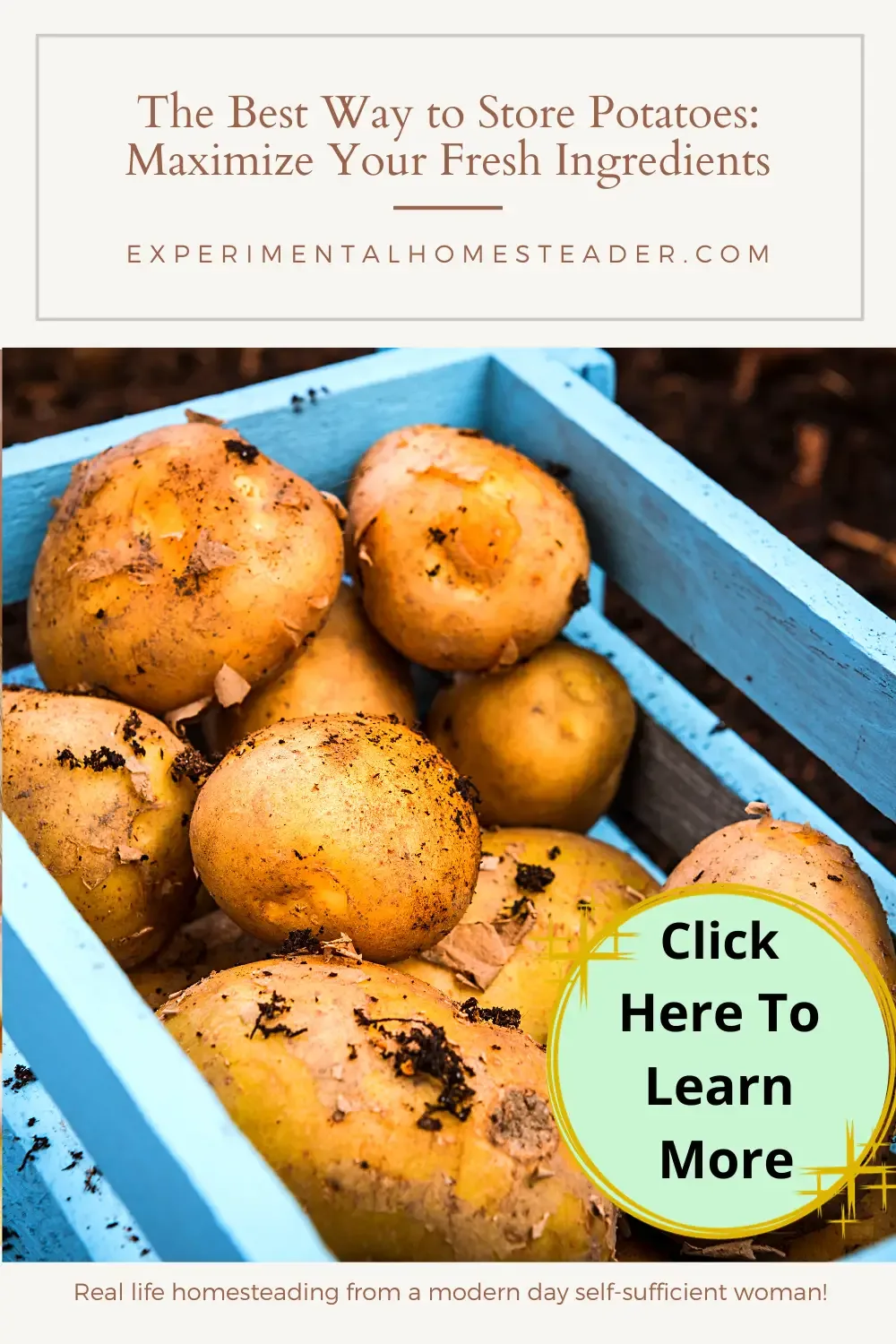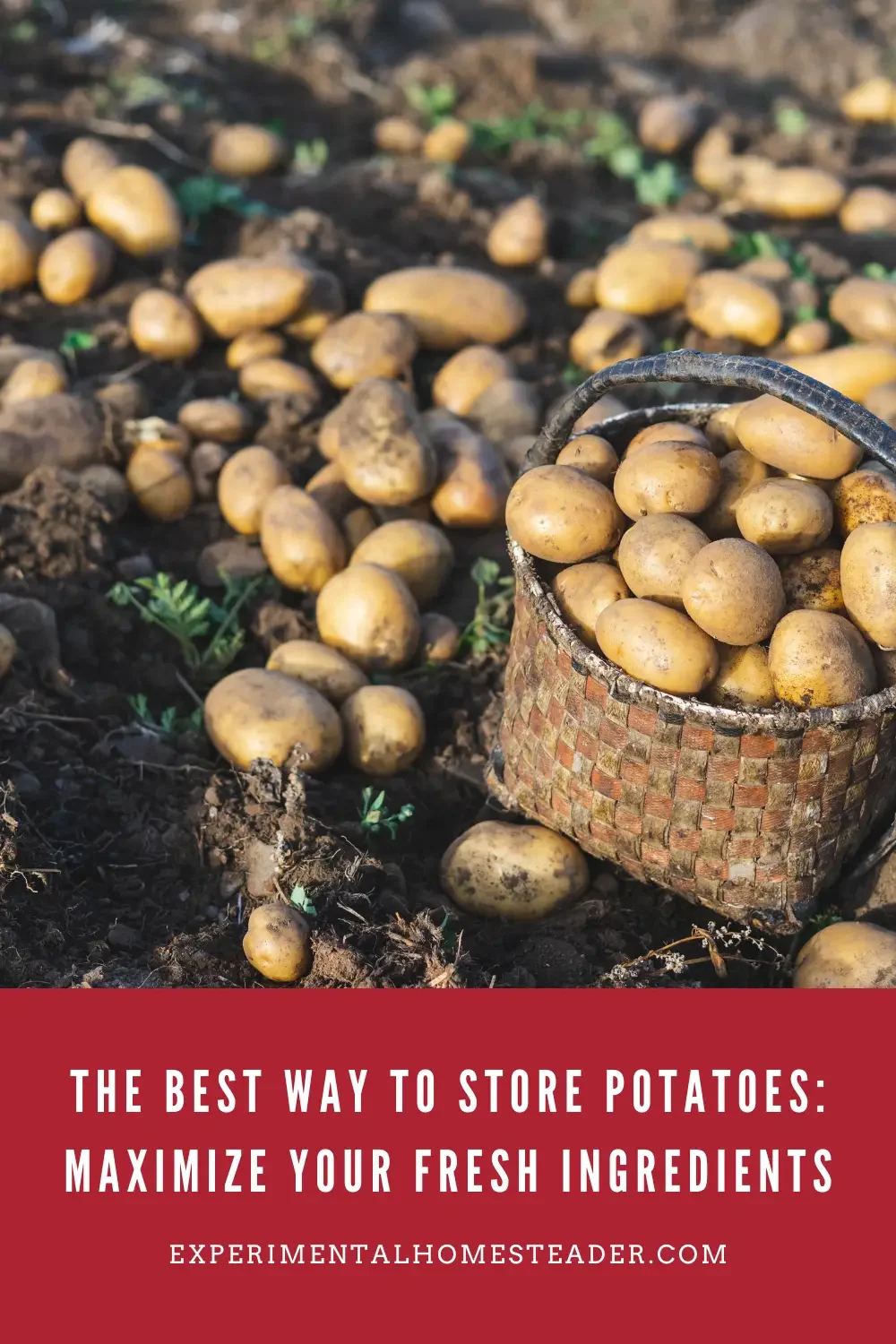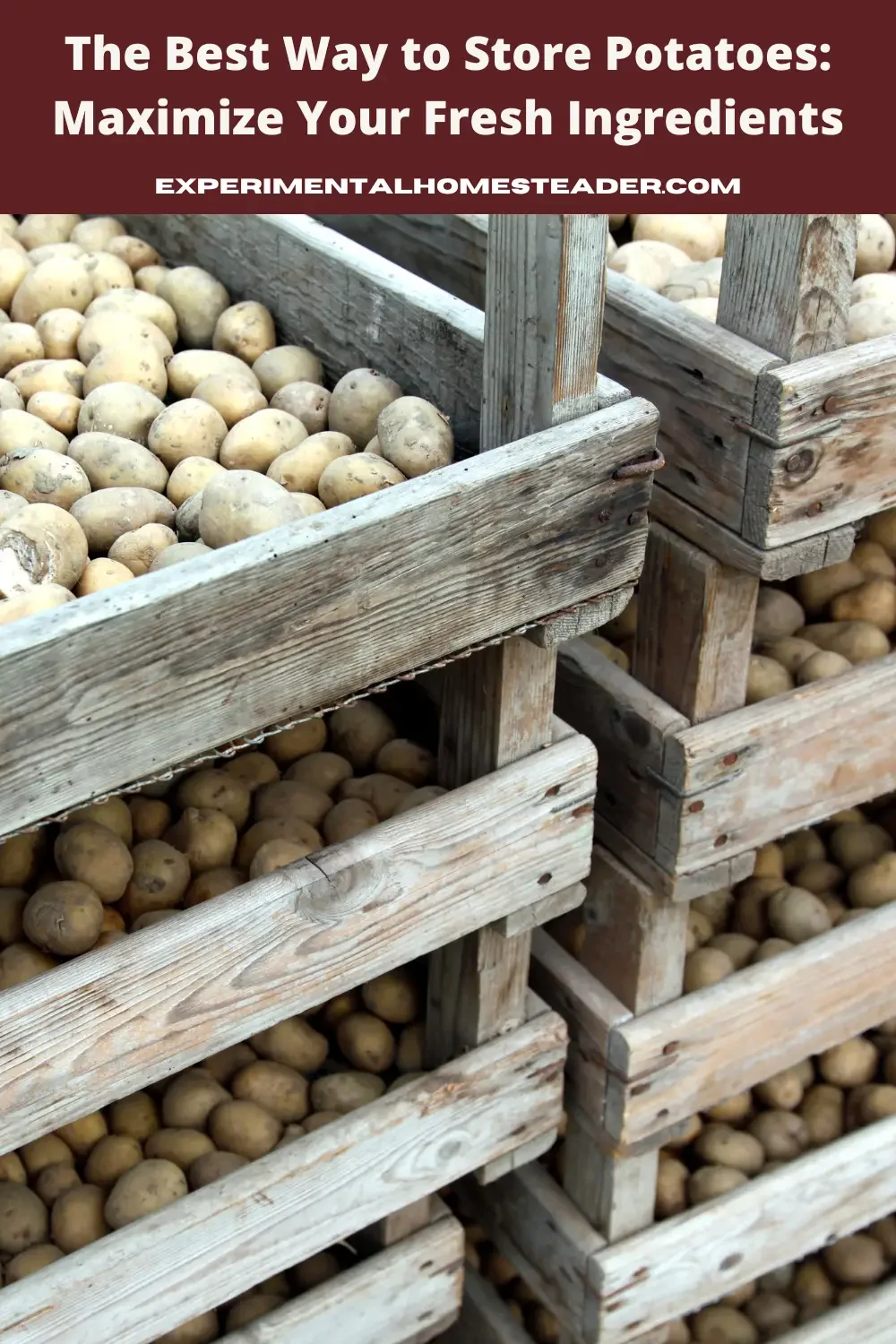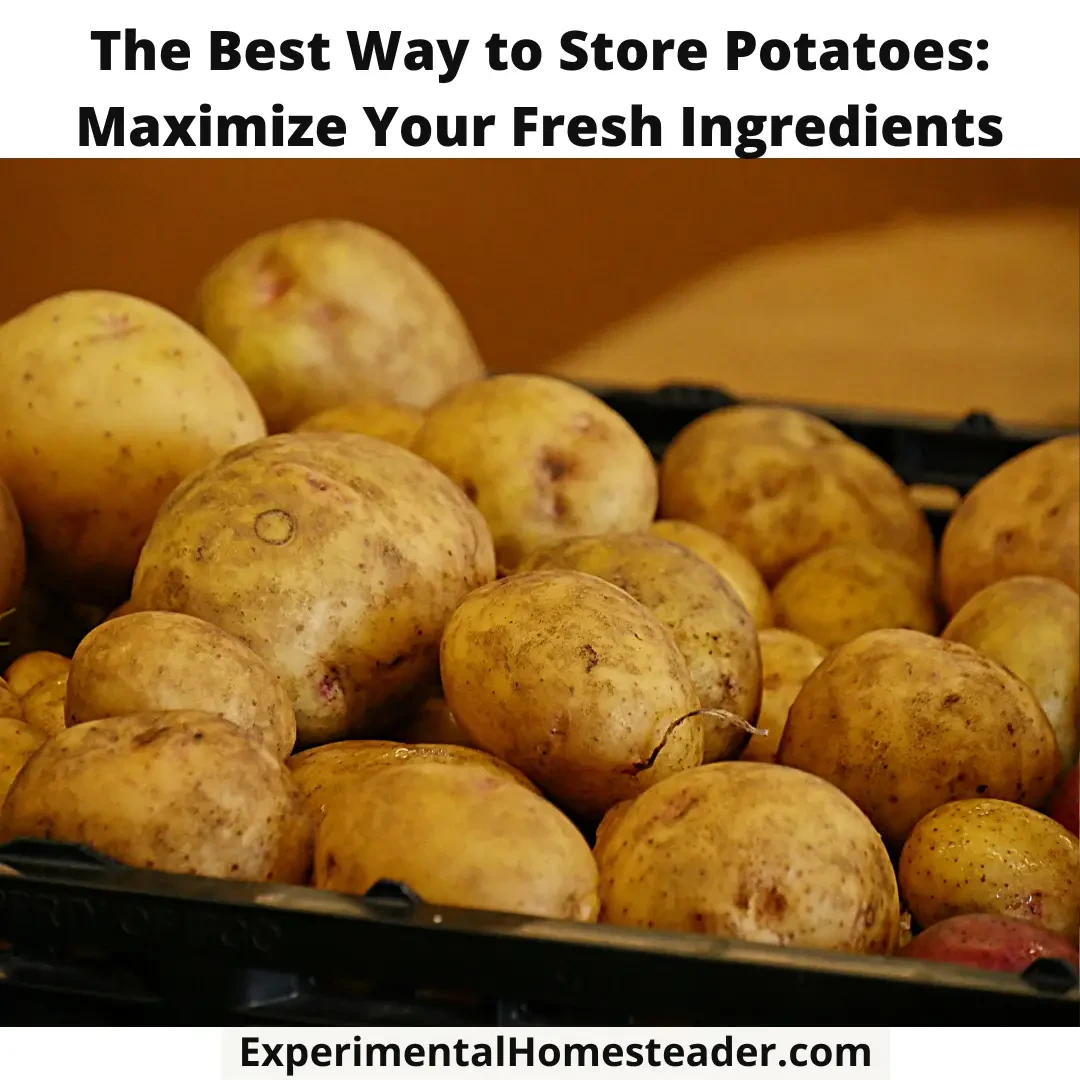Are you looking for the best way to store potatoes for your homestead, especially if you're off-grid and rely on long-term food storage to sustain you through the winter?
We've got you covered.
Anyone who's tried to store purchased potatoes for extended periods has faced the unfortunate reality that they don't stay fresh forever - and it doesn't matter if you grow them yourself or buy them from the grocery store or farmers' market.
Potatoes are a homesteader's staple, but they often sprout, grow mold, or turn soft, jeopardizing your carefully planned meals.
So, what's the secret to preserving your spuds?
It begins with choosing the right potatoes for storage, understanding the optimal storage conditions, and committing to regular checks and maintenance.
In this in-depth discussion, we'll walk you through these essential steps, ensuring your potatoes remain fresh for extended periods.
With these valuable insights, you can safeguard your winter food supply and ensure that you always have a stash of fresh, homegrown ingredients at your fingertips.
Because, ultimately, your goal is to ensure your pantry is consistently stocked with fresh, homegrown ingredients, enriching your homesteading experience and bolstering your self-sufficiency year-round.
Mastering Potato Storage on the Homestead: A Dirty Little Secret
Potatoes, the unsung heroes of our kitchen, are a staple on the homestead.
But the art of storing these versatile tubers can make all the difference in keeping them fresh as the day you pulled them from the earth.
So, let's dive into some down-to-earth tips for preserving your potato harvest in its prime.
The Scoop on Harvesting
Timing is key.
Wait for a sunny day with dry ground to dig up your treasures.
Moisture is your arch-nemesis, and a bit of sunshine can work wonders to dry out those spuds.
When it comes to the nitty-gritty of potato harvesting, here's the deal – keep that dirt on!
No need for fancy scrubbing; just give your spuds a gentle brush to rid them of excess soil.
That layer of earth?
It's like a natural suit of armor for your potatoes.
Curing Potatoes for Longevity
Now, let's get to the magic of curing.
Find a well-ventilated, somewhat dark space with temperatures between 50 and 65°F.
Spread your freshly unearthed potatoes on a screen or cardboard.
But here's the thing – they need their personal space.
Giving them room to breathe prevents moisture buildup and spoilage.
Let them hang out in this environment for about ten days, toughening up along the way.
In-Ground Storage – Homesteader Style
For those of us blessed with milder climates, there's a clever trick to store potatoes right in the ground – perfect for the homestead.
Here's how:
- Straw Selection: When you're getting your straw, make sure it's not loaded with seed heads. We definitely don't want a surprise wheat field in the potato patch next season. I recommend skipping the hay; it tends to get moldy and has a lot more seeds.
- Blanket Your Spuds: Take that straw and generously cover your potato plants with about four to six inches of it. It's not just for insulation; it keeps the humidity at the perfect level for your spuds.
- Weather Watch: Keep a close eye on the weather. If winter starts knocking on your door, add more straw for extra protection.
- Regular Checks: It's a must to regularly peek in on your potato beds. Make sure they're snug and well-covered. Exposure to light is a big no-no as it encourages sprouting.
- Drainage Matters: Ensure your soil drains well to avoid any potato disasters -nobody wants to dig up a soggy spud. Your potatoes can comfortably chill under that straw until the soil temperature hits 55-60°F – typically around April in my neck of the woods.
- Crop Rotation: Here's a golden nugget – consider crop rotation. It's your trusty sidekick in the battle against potato diseases. A simple yet highly effective way to keep your potato patch thriving year after year.
If you're not a fan of leaving your precious potatoes in the ground, or perhaps you're dealing with heavy snowfall and deep freezes, fear not.
There's a perfect solution for storing your spuds, and it doesn't involve any magic tricks or complicated equipment.
The best way to store your homegrown potatoes is by creating your very own root cellar or utilizing your basement.
But wait, there's more – you can also get away with a cool, dark cabinet or closet.
It's all about finding the right spot to keep your tuber treasures safe and sound.
Now, let's dive into the nitty-gritty of how to make this happen.
Whether you're a seasoned homesteader or just starting out, these next steps will help you keep your potatoes fresh and delicious until you're ready to whip up some mouthwatering meals.
The Art of Selecting Potatoes: A Guide for Long-Term Storage
Potatoes, cherished treasures in homestead kitchens everywhere, are revered for their role in creating hearty, farm-to-table feasts.
Whether you're crafting vibrant salads, hearty roasts, satisfying fries, or comforting mashed potatoes, these resilient tubers unquestionably infuse substance and delectable flavor into every homestead meal.
But for the dedicated homesteader, selecting the perfect potatoes for long-term storage is more than a culinary choice – it's an essential skill.
Here, we share top-notch tips for homesteaders, helping you handpick the ideal potatoes that promise enduring freshness and consistently delicious farm-to-table fare.
Start by selecting the right type of potato.
Russet potatoes, with their thick, rough skins, are designed by nature for long-term durability and are an excellent choice for this purpose.
Very resistant to spoilage, these tubers have the ability to last for several months when stored under ideal conditions.
When selecting individual potatoes, look for those that are firm and plump, devoid of any soft spots, bruising, or other apparent forms of damage.
These potatoes are likely to rot faster forcing you to toss away your beloved spuds sooner than anticipated.
Make it a point to avoid potatoes with a greenish tinge underneath the skin.
The chemical responsible for this hue, solanine, builds up when tubers are exposed to light for extended periods.
Not only does this increase their bitterness, but in large quantities, it can be toxic.
Examining the potato's eyes is essential too.
Potatoes with too many eyes tend to sprout sooner, which significantly reduces their shelf life.
Opt for potatoes with fewer eyes for longer-lived spuds.
In the realm of potatoes, size does matter!
Larger potatoes tend to keep better than smaller ones.
This is due to the lesser surface area exposed to air, reducing the risk of decay or rot setting in sooner.
When it comes to stocking up on potatoes, whether you're purchasing them or cultivating your own, it's crucial to consider the available storage conditions.
Your storage space plays a pivotal role in determining the quantity you should acquire, ensuring that your precious potato harvest remains in prime condition.
Potatoes thrive in a cool, dark, well-ventilated environment, ideally with a temperature between 45 and 50 degrees Fahrenheit.
Any warmer, and they may start to sprout or soften; colder, and their starches convert to sugar.
Humidity also plays a role, as dry conditions can lead to shriveled potatoes, while damp ones may encourage mold.
It's also crucial to store potatoes far from onions.
When close together, these two release gases that accelerate ripening and, ultimately, spoilage.
Choosing the best potatoes for long-term storage isn't rocket science.
By keeping these practical points in mind, anyone can select superb spuds that last longer, taste better, and provide a cornucopia of divine dishes.
The ubiquitous potato serves as more than just a companion to steak - it is a testament to our shared celebration of simple yet hearty food, connecting us all through the universal language of flavor and satisfaction.
Understanding the Optimal Storage Conditions
Let's venture even further into our delightful potato journey.
You've mastered the art of selecting the perfect potato, carefully inspecting for blemishes and off-color areas.
Now, it's time to nurture these potatoes in their post-harvest life.
The way we store our potatoes has a profound impact on their longevity, flavor, and their ability to shine in our wholesome, farm-to-table creations.
Picture a dark, cool, well-ventilated spot, and there you have the ideal home for your potatoes.
While the refrigerator may seem like the perfect fit with its dark and cool climate, please resist.
The temperature of refrigerators is typically too low, causing the potato's starches to convert into sugar.
This can result in a sweet, grainy texture upon cooking – a nightmare for any spud-loving home cook.
A pantry, cellar, or even simply a dark, airy cabinet away from heat sources forms our ideal potato sanctuary, maintaining a temperature range of 45 to 50 degrees Fahrenheit.
This ensures your taters remain in prime condition and ready for all your farm-fresh culinary endeavors.
Potatoes are humble folks.
They don't need much, but humidity is their best friend.
A moderately humid environment (think 80-90%), often naturally achieved in your potato's dark hiding place, ensures your potatoes remain hydrated, slowing their irony shrivel into spud oblivion.
However, while humidity is an essential aspect of potato storage, a damp, soggy setting is a dangerous potato hazard leading to premature spoilage.
Now, onto ventilation; this important yet often overlooked detail is key to maintaining the fresh character of your potato.
A well-ventilated space allows ethylene gas, naturally produced by potatoes and other fruits and veggies, to escape.
In a contained environment, this gas accelerates the aging process, encouraging those dreaded sprouts.
Opt, then, for a storage container that allows your potatoes to breathe, such as a fabric bag or a wooden or a wooden or cardboard box with ample airflow.
If you've come this far, you're certainly a homesteader who values their potatoes.
However, in the world of potatoes, solitude is essential for long-term storage.
Some fruits and vegetables, like apples, bananas, and our trusty onion companions, release ethylene gas, which can accelerate sprouting.
Therefore, it's best to store your potatoes separately, allowing them ample room to peacefully rest and stay fresh.
And there you have it, a practical guide to potato care for the homesteader.
Here, the humble spud isn't simply tossed aside but treated with the utmost culinary expertise.
Proper storage ensures that when it's time to peel them for that creamy gratin or slice them for those golden roasties, they remain fresh, full of flavor, and eagerly await their transformation in your skilled hands.
Until that moment, let them rest, quietly nurtured under your watchful eye.
Embracing the patience needed for this process is key.
Once you've mastered the art of keeping your potatoes through the winter, take a moment to celebrate, for you've gained another essential skill for your homesteading toolbox – becoming a pro in potato storage.
You're not only skilled in selecting the best potatoes but also in preserving them to perfection.
Frequent Checks and Maintenance
Carrying forward our passion for potatoes, let's spill the beans about a critical step - potato inspection frequency - something that's pivotal while long-term storage is the game.
Trust me, regular checks are the key to preserving those spuds in perfect shape.
And by regular, we imply a good week-over-week inspection.
Inspecting potatoes every seven days keeps any spoilage in check and promotes a healthy rotation of your stash.
It allows you to catch any early signs of decay or sprouting and address the issue before it spreads to the rest of the lot.
It's like a regular health checkup for your precious bulbs.
Wouldn't you love to save your handpicked, carefully stored potatoes from becoming a rotting mess?
Of course!
That's the beauty of frequent food storage inspections.
Spot a potato turning soft or manifesting signs of discoloration?
Instantly, remove it from the group.
This proactive maneuver keeps the remaining undamaged potatoes in pristine condition, elongating their edible life, and ensuring you always have access to fresh, flavorful spuds for your cooking experiments.
But inspection isn't just about spotting the spoiled ones.
Every seasoned homesteader understands that the foundation of delicious meals lies in the use of fresh ingredients.
Storing potatoes long-term doesn't mean compromising on freshness.
Spotting and removing any sprouted potatoes during your weekly inspections gives a clear signal to your vegetables that aging gracefully is the norm here.
Remember, sprouted potatoes can still be consumed after removing all sprouts and eyes, though over-sprouted ones may become bitter and unfit for consumption.
There's an exquisite pleasure in maintaining a well-stocked pantry filled with perfectly stored ingredients that are ready when you need them.
And when the star of the show is the humble potato, the results can be stunningly delicious.
From a crisp-munchy potato chip to a creamy, mouth-melting mashed potato, a well-stored spud can work magic!
So never underestimate the power of a weekly potato inspection.
It offers a splendid reward, infusing your homestead kitchen with the divine aroma of a skillfully crafted meal, and your dining table with the joyful laughter of loved ones savoring your culinary creations.
Rescuing and Repurposing: Giving a Second Life to Aging Potatoes
In the world of homesteading, where self-sufficiency is paramount, every potato from the garden holds value.
A well-stocked root cellar or pantry is a testament to your hard work and dedication.
When you catch potatoes in the early stages of spoilage, it's like finding hidden treasure.
Rather than letting them go to waste, resourceful homesteaders can repurpose these potatoes, giving them a second chance to shine in the kitchen.
By simply cutting up the slightly compromised ones and employing preservation techniques such as freezing or canning, you breathe new life into them.
These 'second-chance' potatoes can be incorporated into various dishes, from soups to casseroles, ensuring that even those slightly past their prime contribute to your culinary creations.
In the world of homesteading, every resource is precious.
Regular inspection of your potato stores is an invaluable practice that allows you to make the most of your harvest.
It's a small but crucial step toward reducing waste, embracing sustainability, and boosting your self-sufficiency.
So, don't forget to give your potato stores a routine check-up – it's a small, but vital habit that yields big rewards on your homesteading journey.
Safeguarding Your Potato Harvest for the Long Haul
So, if you're tired of wasting potatoes, the solution might be simpler than you think.
It's a blend of dedication, knowledge, and straightforward household techniques.
The art of storing potatoes is about selecting the right, mature, and robust specimens, creating an environment that mimics their natural storage conditions, and consistently monitoring their well-being.
By following these steps, you can savor those homegrown farm-fresh potatoes a little longer before they become a delightful addition to your dinner table.
It's time to put an end to the waste and maximize your investment in this delicious, versatile, and nutritious staple.
Here's to a bountiful basket of fresh potatoes, ready for every culinary adventure!
FAQ: Long-Term Potato Storage for Homesteaders
In the world of homesteading, where self-sufficiency is paramount, every potato from the garden carries significant value.
Your diligently stocked root cellar or pantry stands as a testament to your unwavering dedication and hard work.
Q. What type of potatoes are best for long-term storage?
A. Generally, varieties like Russet, Katahdin, or Kennebec are excellent choices for long-term storage due to their thicker skins and lower moisture content.
Q. How should I prepare potatoes for storage?
A. First, let them air-dry for a few hours after digging them up. Then, remove excess dirt but don't wash them. Make sure there are no cuts in the potatoes as those will rot first. The soil helps protect the potatoes.
Q. Can I store potatoes with other vegetables?
A. It's best to keep potatoes separate from vegetables like onions, as they can emit gases that affect each other's storage life.
Q. What's the ideal temperature and humidity for potato storage?
A. Aim for temperatures around 45-50°F (7-10°C) and humidity levels between 90-95%.
Q. Should I store potatoes in the dark or with some light exposure?
A. Potatoes should be stored in the dark to prevent greening. Even a small amount of light can trigger the development of solanine, which is toxic when consumed.
Q. Can I freeze potatoes for long-term storage?
A. Yes, you can freeze potatoes, but they should be blanched first. Keep in mind that freezing can change their texture, making them better suited for dishes like soups and stews. Frozen potatoes also make great hash browns.
Q. Are there natural methods to prevent sprouting?
A. Yes, storing potatoes with apples or onions can help inhibit sprouting, thanks to the gases they emit. Alternatively, you can use sprout inhibitors like ethylene gas absorbers.
Q. What's the role of humidity in potato storage?
A. Humidity helps prevent excessive moisture loss from the potatoes, keeping them from shriveling and becoming less palatable.
Q. How do I deal with sprouted potatoes?
A. Gently remove the sprouts before using the potatoes. The remaining parts are still good to eat. Remove any potatoes that are starting to sprout from your long-term storage however and use them up right away.
Q. Can I store potatoes in plastic bags or containers?
A. It's best to avoid airtight plastic bags or containers, as they can trap moisture and encourage rot. Use burlap sacks, paper bags, or wooden crates instead. Keeping potatoes in a single layer and not stacked also helps to prolong storage.
Q. What's the shelf life of stored potatoes?
A. When properly stored, potatoes can last 3-8 months or even longer, depending on the variety and conditions.
Q. How can I check on stored potatoes to prevent spoilage?
A. Regularly inspect your potato stores for any signs of rot, sprouting, or other issues. Remove affected potatoes to prevent the spread of spoilage.
Q. Can I can potatoes for long-term storage?
A. Yes, you can can potatoes using pressure canning methods. This can extend their shelf life for several years. While most of the time people can potatoes in water using beef or chicken broth greatly enhances the taste - and feel free to add in some of your favorite herbs.
Q. How do I know if a stored potato is no longer safe to eat?
A. If a potato is soft, has mold, or emits an unpleasant odor, it's best to discard it.
Q. Can I store cooked potatoes for long-term use?
A. It's challenging to store cooked potatoes for extended periods. Freezing might be an option, but texture and flavor can change.
Q. What is the best way to store seed potatoes for the following planting season?
A. Keep seed potatoes in a cool, dark place with good ventilation. Avoid storing them in the refrigerator, which can affect their ability to sprout. Also be sure the seed potatoes are clean with no signs of disease or other issues. It is best to discard any that have problems so they do not affect your entire crop the following year.
Q. Can I store different potato varieties together, or should they be kept separately?
A. Different potato varieties can be stored together, as long as they share similar storage requirements in terms of temperature and humidity. Keep an eye on the variety that requires the most specific conditions.
Q. What is the best way to store potatoes if you're off-grid or in an area with unreliable electricity?
A. Off-grid homesteaders can rely on root cellars or cool, well-ventilated basements for potato storage. It's essential to have backup systems, like solar power, to maintain proper conditions.
Q. Are there any pests or diseases I should watch out for when storing potatoes long term?
A. Common issues include potato scab, late blight, and insect infestations. Proper storage conditions can help minimize these risks.
<div
data-shortcode="mv_create"
data-attributes='{DQUOTEkeyDQUOTE:DQUOTE131DQUOTE,DQUOTElayoutDQUOTE:DQUOTEcirclesDQUOTE,DQUOTEthumbnailDQUOTE:DQUOTEhttps://experimentalhomesteader.com/wp-content/uploads/1999/01/rootcellareh2.pngDQUOTE,DQUOTEtitleDQUOTE:DQUOTEFood
Food





